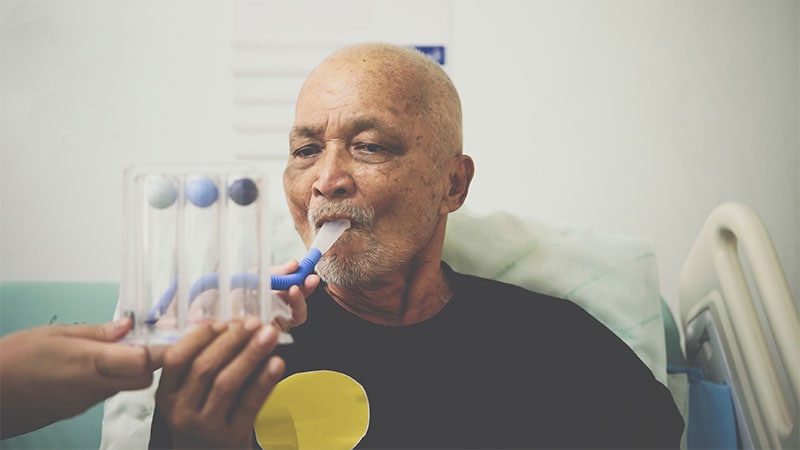Spirometry Predicts Mortality Risk in Type 2 Diabetes Patients
Core Concepts
PRISm in type 2 diabetes patients predicts increased mortality risk and complications.
Abstract
The study focused on the association between preserved ratio impaired spirometry (PRISm) and mortality risk in individuals with type 2 diabetes. Here is a breakdown of the key points:
Key Points:
PRISm linked to higher mortality and complications in type 2 diabetes.
Study reviewed data from 20,047 individuals with type 2 diabetes.
PRISm defined as FEV1 < 80% with FEV1/FVC ratio ≥ 0.70.
PRISm associated with increased risk of macro- and microvascular complications.
Individuals with PRISm more likely to be smokers, obese, and have diabetes.
PRISm significantly linked to cardiovascular, respiratory, and all-cause mortality.
Adding PRISm to risk score improved predictive power for complications.
Potential mechanisms include insulin resistance and pulmonary artery enlargement.
Study limitations include population homogeneity and exclusion of diabetic neuropathy.
Spirometry Predicts Mortality in Type 2 Diabetes
Stats
PRISm occurs in approximately 10% of the general population.
16.9% of study participants had obstructive spirometry.
22.6% of participants had PRISm.
5.0% developed incident MI over 12 years.
15.1% of patients died during the study period.
Quotes
"A growing number of studies have demonstrated that impaired lung function and type 2 diabetes could trigger shared pathophysiological injuries."
"The findings underscore the relevance of PRISm for prognostic classification in type 2 diabetes."
Key Insights Distilled From
by Heidi Splete at www.medscape.com 07-12-2023
https://www.medscape.com/viewarticle/994288
Deeper Inquiries
How can the findings of this study impact the current treatment strategies for type 2 diabetes patients
The findings of this study can significantly impact current treatment strategies for type 2 diabetes patients by highlighting the importance of assessing lung function through spirometry. Identifying preserved ratio impaired spirometry (PRISm) in these patients can serve as an early predictor of adverse outcomes, including macrovascular and microvascular complications, as well as increased mortality. Healthcare providers can use this information to tailor treatment plans for individuals with type 2 diabetes, focusing on interventions that not only manage blood glucose levels but also address potential respiratory issues. Incorporating regular spirometry assessments into the standard care protocol for type 2 diabetes patients can help in early detection of PRISm and prompt initiation of appropriate interventions to mitigate the associated risks.
What are the potential implications of PRISm as a predictor of adverse outcomes in other chronic conditions
The potential implications of PRISm as a predictor of adverse outcomes in other chronic conditions are significant. Beyond type 2 diabetes, PRISm could serve as a valuable prognostic indicator in various chronic diseases where impaired lung function is prevalent. For conditions such as cardiovascular diseases, chronic obstructive pulmonary disease (COPD), and even certain cancers, the presence of PRISm may signal an increased risk of complications and mortality. Healthcare providers could consider incorporating spirometry assessments, specifically looking for PRISm, in the routine care of patients with these chronic conditions. Early identification of PRISm could lead to more targeted treatment strategies, improved monitoring of disease progression, and potentially better outcomes for individuals with these health issues.
How might the inclusion of diabetic neuropathy in the analysis have influenced the results of the study
The inclusion of diabetic neuropathy in the analysis could have influenced the results of the study by providing a more comprehensive understanding of the relationship between lung function, diabetes complications, and mortality. Diabetic neuropathy, a common complication of diabetes affecting the nerves, could have added another layer of complexity to the findings. By considering diabetic neuropathy alongside PRISm and other variables, researchers could have explored potential interactions and synergistic effects that may impact the outcomes observed. Understanding how diabetic neuropathy interacts with impaired lung function and its implications on diabetes-related complications and mortality could have provided a more nuanced perspective on the overall risk profile of individuals with type 2 diabetes. Including diabetic neuropathy in future studies could offer a more holistic view of the factors influencing health outcomes in this population.
0
